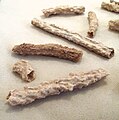Transformers theme by Christoforo
Download: Transformers.p3t
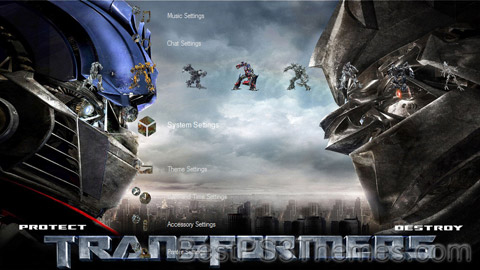
(1 background)
| Transformers | |
|---|---|
Franchise logo, 2014–present | |
| Created by | |
| Original work | Transformers (based on Diaclone and Micro Change) |
| Years | 1984–present |
| Print publications | |
| Book(s) | Complete list |
| Comics | Complete list |
| Films and television | |
| Film(s) | Animated |
| Animated series | Complete list |
| Games | |
| Video game(s) | Complete list |
| Audio | |
| Soundtrack(s) | Transformers audio releases |
| Miscellaneous | |
| Related franchises | |
Transformers is a media franchise produced by American toy company Hasbro and Japanese toy company Takara Tomy. It primarily follows the heroic Autobots and the villainous Decepticons, two alien robot factions at war that can transform into other forms, such as vehicles and animals. The franchise encompasses toys, animation, comic books, video games and films. As of 2011, it generated more than ¥2 trillion ($25 billion) in revenue,[1] making it one of the highest-grossing media franchises of all time.
The franchise began in 1984 with the Transformers toy line, comprising transforming mecha toys from Takara's Diaclone and Micro Change toylines rebranded for Western markets.[2] The term "Generation 1" covers both the animated television series The Transformers and the comic book series of the same name, which are further divided into Japanese, British and Canadian spin-offs, respectively. Sequels followed, such as the Generation 2 comic book and Beast Wars TV series, which became its own mini-universe. Generation 1 characters have been rebooted multiple times in the 21st century in comics from Dreamwave Productions (starting 2001), IDW Publishing (starting in 2005 and again in 2019), and Skybound Entertainment (beginning in 2023). There have been other incarnations of the story based on different toy lines during and after the 20th century. The first was the Robots in Disguise series, followed by three shows (Armada, Energon, and Cybertron) that constitute a single universe called the "Unicron Trilogy".
A live-action film series started in 2007, again distinct from previous incarnations, while the Transformers: Animated series merged concepts from the G1 continuity, the 2007 live-action film and the "Unicron Trilogy". For most of the 2010s, in an attempt to mitigate the wave of reboots, the "Aligned Continuity" was established. In 2018, Transformers: Cyberverse debuted, once again, distinct from the previous incarnations.
Although initially a separate and competing franchise started in 1983, Tonka's GoBots became the intellectual property of Hasbro after their buyout of Tonka in 1991. Subsequently, the universe depicted in the animated series Challenge of the GoBots and follow-up film GoBots: Battle of the Rock Lords was retroactively established as an alternate universe within the Transformers multiverse.[3]
Fiction[edit]
Transformers: Generation 1 (1984–1993)[edit]


Generation One is a retroactive term for the Transformers characters that appeared between 1984 and 1993. The Transformers began with the 1980s Japanese toy lines Micro Change and Diaclone. They presented robots able to transform into everyday vehicles, electronic items or weapons. Hasbro bought the Micro Change and Diaclone toys, and partnered with Takara.[4] Marvel Comics was hired by Hasbro to create the backstory; editor-in-chief Jim Shooter wrote an overall story, and gave the task of creating the characters to writer Dennis O'Neil.[5] Unhappy with O'Neil's work (although O'Neil created the name "Optimus Prime"), Shooter chose Bob Budiansky to create the characters.[6]
The Transformers mecha were largely designed by Shōji Kawamori, the creator of the Japanese mecha anime franchise Macross (which was adapted into the Robotech franchise in North America).[7] Kawamori came up with the idea of transforming mechs while working on the Diaclone and Macross franchises in the early 1980s (such as the VF-1 Valkyrie in Macross and Robotech), with his Diaclone mechs later providing the basis for Transformers.[8]
The primary concept of Generation One is that the heroic Optimus Prime, the villainous Megatron, and their finest soldiers crash-land on prehistoric Earth in the Ark and the Nemesis before awakening in 1985, Cybertron hurtling through the Neutral zone as an effect of the war. The Marvel comic was originally part of the main Marvel Universe, with appearances from Spider-Man and Nick Fury, plus some cameos,[9] as well as a visit to the Savage Land.[10]
The Transformers TV series began around the same time. Produced by Sunbow Productions and Marvel Productions, later Hasbro Productions, from the start it contradicted Budiansky's backstories. The TV series shows the Autobots looking for new energy sources, and crash landing as the Decepticons attack.[11] Marvel interpreted the Autobots as destroying a rogue asteroid approaching Cybertron.[12] Shockwave is loyal to Megatron on the TV series, keeping Cybertron in a stalemate during his absence,[13] but in the comic book, he attempts to take command of the Decepticons.[14] The TV series would also differ wildly from the origins Budiansky had created for the Dinobots,[15][16] the Decepticon turned Autobot Jetfire[17] (known as Skyfire on TV[18]), the Constructicons (who combine to form Devastator),[19][20] and Omega Supreme.[19][21] The Marvel comic establishes early on that Prime wields the Creation Matrix, which gives life to machines. In the second season, the two-part episode The Key to Vector Sigma introduced the ancient Vector Sigma computer, which served the same original purpose as the Creation Matrix (giving life to Transformers), and its guardian Alpha Trion.
In 1986, the cartoon became the film The Transformers: The Movie, which is set in the year 2005. It introduced the Matrix as the "Autobot Matrix of Leadership", as a fatally wounded Prime gives it to Ultra Magnus; however, as Prime dies he drops the matrix, which is then caught by Hot Rod who subsequently becomes Rodimus Prime later on in the film. Unicron, a Transformer who devours planets, fears its power and re-creates a heavily damaged Megatron as Galvatron, as well as Bombshell or Skywarp becoming Cyclonus, Thundercracker becoming Scourge and two other Insecticons becoming Scourge's huntsmen, the Sweeps. Eventually, Rodimus Prime takes out the Matrix and destroys Unicron.[22] In the United Kingdom, the weekly comic book interspliced original material to keep up with U.S. reprints,[23] and The Movie provided much new material. Writer Simon Furman proceeded to expand the continuity with movie spin-offs involving the time travelling Galvatron.[24][25] The Movie also featured guest voices from Leonard Nimoy as Galvatron, Scatman Crothers as Jazz, Casey Kasem as Cliffjumper, Orson Welles as Unicron and Eric Idle as the leader of the Junkions (Wreck-Gar, though unnamed in the movie). The Transformers theme tune for the film was performed by Lion with "Weird Al" Yankovic adding a song to the soundtrack.
The third season followed up The Movie, with the revelation of the Quintessons having used Cybertron as a factory. Their robots rebel, and in time the workers become the Autobots and the soldiers become the Decepticons. (Note: This appears to contradict background presented in the first two seasons of the series.) It is the Autobots who develop transformation.[26] Due to popular demand,[27] Optimus Prime is resurrected at the conclusion of the third season,[28] and the series ended with a three-episode story arc. However, the Japanese broadcast of the series was supplemented with a newly produced OVA, Scramble City, before creating entirely new series to continue the storyline, ignoring the 1987 end of the American series. The extended Japanese run consisted of The Headmasters, Super-God Masterforce, Victory and Zone, then in illustrated magazine form as Battlestars: Return of Convoy and Operation: Combination. Just as the TV series was wrapping up, Marvel continued to expand its continuity. It follows The Movie's example by killing Prime[29] and Megatron,[30] albeit in the present day. Dinobot leader Grimlock takes over as Autobot leader.[31] There was a G.I. Joe crossover[32] and the limited series The Transformers: Headmasters, which further expanded the scope to the planet Nebulon.[33] It led on to the main title resurrecting Prime as a Powermaster.[34]
In the United Kingdom, the mythology continued to grow. Primus is introduced as the creator of the Transformers, to serve his material body that is planet Cybertron and fight his nemesis Unicron.[35] Female Autobot Arcee also appeared, despite the comic book stating the Transformers had no concept of gender, with her backstory of being built by the Autobots to quell human accusations of sexism.[36] Soundwave, Megatron's second-in-command, also breaks the fourth wall in the letters page, criticising the cartoon continuity as an inaccurate representation of history.[37] The UK also had a crossover in Action Force, the UK counterpart to G.I. Joe.[38] The comic book features a resurrected Megatron,[39] whom Furman retconned to be a clone[40] when he took over the U.S. comic book, which depicted Megatron as still dead.[41] The U.S. comic would last for 80 issues until 1991,[42] and the UK comic lasted 332 issues and several annuals, until it was replaced as Dreamwave Productions, later in the 20th-Century.
In 2009, Shout! Factory released the entire G1 series in a 16-DVD box set called the Matrix of Leadership Edition.[43] They also released the same content as individual seasons.[44]
Transformers: Generation 2 (1993–1995)[edit]
It was five issues[45] of the G.I. Joe comic in 1993 that would springboard a return for Marvel's Transformers, with the new twelve-issue series Transformers: Generation 2, to market a new toy line.
This story reveals that the Transformers originally breed asexually, though it is stopped by Primus because it produced the evil Swarm.[46] A new empire, neither Autobot nor Decepticon, is bringing it back, however. Though the year-long arc wrapped itself up with an alliance between Optimus Prime and Megatron, the final panel introduces the Liege Maximo, ancestor of the Decepticons.[47] This minor cliffhanger was not resolved until 2001 and 2002's Transforce convention when writer Simon Furman concluded his story in the exclusive novella Alignment.[48]
Beast Wars and Beast Machines (1996–2000)[edit]
The story focuses on a small group of Maximals (the new Autobots), led by Optimus Primal, and Predacons, led by Megatron, 300 years after the "Great War". After a dangerous pursuit through transwarp space, both the Maximal and Predacon factions end up crash landing on a primitive, uncivilized planet similar to Earth, but with two moons and a dangerous level of Energon (which is later revealed to be prehistoric Earth with an artificial second moon, taking place sometime during the 4 million year period in which the Autobots and Decepticons were in suspended animation from the first episode of the original Transformers cartoon), which forces them to take organic beast forms in order to function without going into stasis lock.[49] After writing this first episode, Bob Forward and Larry DiTillio learned of the G1 Transformers and began to use elements of it as a historical backstory to their scripts,[50] establishing Beast Wars as a part of the Generation 1 universe through numerous callbacks to both the cartoon and the Marvel comic. By the end of the first season, the second moon and the Energon are revealed to have been constructed by a mysterious alien race known as the Vok.

The destruction of the second moon releases mysterious energies that make some of the characters "transmetal" and the planet is revealed to be prehistoric Earth, leading to the discovery of the Ark. Megatron attempts to kill the original Optimus Prime,[51] but at the beginning of the third season, Primal manages to preserve his spark. In the two-season follow-up series, Beast Machines, Cybertron is revealed to have organic origins, which Megatron attempts to stamp out.
After the first season of Beast Wars (comprising 26 episodes) aired in Japan, the Japanese were faced with a problem. The second Canadian season was only 13 episodes long, not enough to warrant airing on Japanese TV. While they waited for the third Canadian season to be completed (thereby making 26 episodes in total when added to season 2), they produced two exclusive cel-animated series of their own, Beast Wars II (also called Beast Wars Second) and Beast Wars Neo, to fill in the gap. Dreamwave retroactively revealed Beast Wars to be the future of their G1 universe,[52] and the 2006 IDW comic book Beast Wars: The Gathering eventually confirmed the Japanese series to be canon[53] within a story set during Season 3.[54]
Beast Wars contained elements from both the G1 cartoon series and comics. Attributes taken from the cartoon include Transformers that were female, the appearance of Starscream (who mentions being killed off by Galvatron in The Transformers: The Movie), and appearances of the Plasma Energy Chamber and Key to Vector Sigma. The naming of the Transformer ship, the Ark (and reference to 1984, the year the Transformers on board are revived), the character Ravage being shown as intelligent, and Cybertron having an organic core are elements taken from the comics.
In 2011, Shout! Factory released the complete series of Beast Wars on DVD.[55]
Dreamwave Productions (2001–2005)[edit]
In 2001, Dreamwave Productions began a new universe of annual comics adapted from Marvel, but also included elements of the animated. The Dreamwave stories followe the concept of the Autobots defeating the Decepticons on Earth, but their 1997 return journey to Cybertron on the Ark II[56] is destroyed by Shockwave, now ruler of the planet.[57] The story follows on from there and was told in two six-issue limited series, then a ten-issue ongoing series. The series also adds extra complexities such as not all Transformers believing in the existence of Primus,[58] corruption in the Cybertronian government that first led Megatron to begin his war,[59] and Earth having an unknown relevance to Cybertron.[57][60]
Three Transformers: The War Within limited series were also published. These are set at the beginning of the Great War, and identify Prime as once being a clerk named Optronix.[61] Beast Wars was also retroactively stated as the future of this continuity, with the profile series More than Meets the Eye showing the Predacon Megatron looking at historical files detailing Dreamwave's characters and taking his name from the original Megatron.[52] In 2004, this real life universe also inspired three novels[62] and a Dorling Kindersley guide, which focused on Dreamwave as the "true" continuity when discussing in-universe elements of the characters. In a new twist, Primus and Unicron are siblings, formerly a being known as the One. Transformers: Micromasters, set after the Ark's disappearance, was also published. The real life universe was disrupted when Dreamwave went bankrupt in 2005.[63] This left the Generation One story hanging and the third volume of The War Within half finished. Plans for a comic book set between Beast Wars and Beast Machines were also left unrealized.[64]
G.I. Joe crossovers (2003–present)[edit]
Throughout the years, the G1 characters have also starred in crossovers with fellow Hasbro property G.I. Joe, but whereas those crossovers published by Marvel were in continuity with their larger storyline, those released by Dreamwave and G.I. Joe publisher Devil's Due Publishing occupy their own separate real life universes. In Devil's Due, the terrorist organization Cobra is responsible for finding and reactivating the Transformers. Dreamwave's version reimagines the familiar G1 and G.I. Joe characters in a World War II setting, and a second limited series was released set in the present day, though Dreamwave's bankruptcy meant it was cancelled after a single issue. Devil's Due had Cobra re-engineer the Transformers to turn into familiar Cobra vehicles, and released further mini-series that sent the characters travelling through time, battling Serpentor and being faced with the combined menace of Cobra-La and Unicron. During this time, Cobra teams up with the Decepticons. IDW Publishing has expressed interest in their own crossover.[65]
IDW publishing (2005–2022)[edit]
The following year, IDW Publishing rebooted the G1 series from scratch within various limited series and one shots. This allowed long-time writer of Marvel and Dreamwave comics, Simon Furman to create his own universe without continuity hindrance, similar to Ultimate Marvel. This new continuity originally consisted of a comic book series titled The Transformers with a companion series known as The Transformers: Spotlight. The main series was broken up into several story arcs. Eventually, with IDW Publishing losing sales, the series was given a soft reboot. Beginning with All Hail Megatron, the series was set in a new direction, discarding the miniseries and Spotlight format with ongoing comics. By 2012 the series had split into three ongoing series; The Transformers: More Than Meets The Eye, The Transformers: Robots in Disguise (which later changed in 2015 to "The Transformers") and The Transformers: Till All Are One. In 2022, it was announced that IDW lost the publishing rights to Transformers.[66]
Alternative stories[edit]
In January 2006, the Hasbro Transformers Collectors' Club comic wrote a story based on the Transformers Classics toy line, set in the Marvel Comics universe, but excluding the Generation 2 comic. Fifteen years after Megatron crash-lands in the Ark with Ratchet, the war continues with the characters in their Classics bodies.[67]
IDW Publishing introduced The Transformers: Evolutions in 2006, a collection of mini-series that re-imagine and reinterpret the G1 characters in various ways. To date, only one miniseries has been published, Hearts of Steel, placing the characters in an Industrial Revolution-era setting. The series was delayed as Hasbro did not want to confuse newcomers with too many fictional universes before the release of the live-action film.[68]
However, IDW and the original publisher Marvel Comics announced a crossover storyline with the Avengers to coincide with the film New Avengers/Transformers.[69] The story is set on the borders of Symkaria and Latveria, and its fictional universe is set between the first two New Avengers storylines, as well in between the Infiltration and Escalation phase of IDW's The Transformers.[70] IDW editor-in-chief, Chris Ryall hinted at elements of it being carried over into the main continuities,[71] and that a sequel is possible.[72] In June 2018 it was announced there would be Star Trek and Transformers Crossover being released in September 2018.[73]
Transformers: Kiss Players (2006–2007)[edit]
Transformers: Kiss Players (トランスフォーマー キスぷれ, Toransufōmā Kisu Pure), shortened to Kiss Players (キスぷれ, Kisu Pure), is a Japanese Transformers franchise which began in 2006 to 2007 as was helmed by artist and writer Yuki Ohshima. By virtue of being the only Transformers toyline and fiction released in Japan by Takara between the conclusion of Cybertron and the live-acti
Ferrari F430
Ferrari F430 theme by Tactica
Download: F430.p3t

(1 background)
| Ferrari F430 | |
|---|---|
 | |
| Overview | |
| Manufacturer | Ferrari |
| Also called | Ferrari 430 |
| Production | August 2004–May 2009 |
| Model years | 2005–2010 |
| Assembly | Maranello, Italy |
| Designer | Frank Stephenson in collaboration with Pininfarina[1][2] |
| Body and chassis | |
| Class | Sports car (S) |
| Body style | 2-door berlinetta 2-door spider |
| Layout | Longitudinal, Rear mid-engine, rear-wheel drive |
| Related | New Stratos |
| Powertrain | |
| Engine | 4.3 L Ferrari F136 E V8 |
| Power output |
|
| Transmission |
|
| Dimensions | |
| Wheelbase | 2,601 mm (102.4 in) |
| Length | 4,511 mm (177.6 in) |
| Width | 1,923 mm (75.7 in) |
| Height |
|
| Curb weight | 1,517 kg (3,344 lb)[3] 1,569 kg (3,460 lb) (Spider)[4] |
| Chronology | |
| Predecessor | Ferrari 360 |
| Successor | Ferrari 458 |
The Ferrari F430 (Type F131) is a sports car produced by the Italian automobile manufacturer Ferrari from 2004 until 2009 as a successor to the Ferrari 360. The car is an update to the 360 with exterior and performance changes. It was unveiled at the 2004 Paris Motor Show.[7] The F430 was succeeded by the 458 which was unveiled on 28 July 2009.[8]
Overview[edit]
Design[edit]



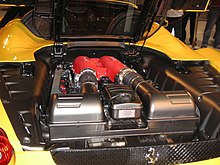
Designed by Pininfarina in collaboration with Frank Stephenson (Director of Ferrari-Maserati Concept Design and Development), the body styling of the F430 was revised from its predecessor, the 360, to improve its aerodynamic efficiency. Although the drag coefficient remained the same, the downforce was greatly enhanced. Despite sharing the same basic Alcoa Aluminium chassis, roofline, doors, and glass, the car looked significantly different from the 360. A great extent of Ferrari heritage was included in the exterior design. At the rear, the Enzo's tail lights and engine cover vents were added. The car's name was etched on the Testarossa-styled driver's side mirror. The large oval openings in the front bumper are reminiscent of Ferrari racing models from the 60s, specifically the 156 "shark nose" Formula One car.
Engine[edit]
The F430 features a 4,308 cc (4.3 L) V8 engine of the "Ferrari-Maserati" F136 family. This new power plant was a significant change for Ferrari, as all previous Ferrari V8's were descendants of the Dino racing program of the 1950s. This fifty-year development cycle came to an end with the entirely new engine used in the F430, the architecture of which replaced the Dino-derived V12 in most other Ferrari cars. The engine's output specifications are: 490 PS (360 kW; 483 hp),[9] at 8,500 rpm and 465 N⋅m (343 lb⋅ft) of torque at 5,250 rpm, 80% of which is available below 3,500 rpm. Despite a 20% increase in displacement, engine weight grew by only 4 kg (8.8 lb) along with a decrease in diameter for easier packaging. The connecting rods, pistons and crankshaft were all entirely new, while the 4-valve cylinder head, valves and intake trumpets were directly retained from Formula 1 engines, for ideal volumetric efficiency. The F430 has a top speed in excess of 315 km/h (196 mph)[2] and can accelerate from 0 to 97 km/h (60 mph) in 3.6 seconds, 0.6 seconds quicker than the old model.[10]
Brakes[edit]
The brakes on the F430 were developed in close cooperation with Brembo and Bosch,[11] resulting in a new cast-iron alloy for the discs. The new alloy includes molybdenum which has a better heat dissipation performance. The F430 was also available with the optional Carbon fibre-reinforced Silicon Carbide (C/SiC) ceramic composite brake package. Ferrari claimed the carbon ceramic brakes will not fade even after 300-360 laps at their test track.
Features[edit]
The F430 featured the E-Diff, a computer-controlled limited slip active differential which can vary the distribution of torque based on inputs such as steering angle and lateral acceleration.[7][12]
Other notable features include the first application of Ferrari's manettino steering wheel-mounted control knob.[7] Drivers can select from five different settings which modify the vehicle's ESC system, "Skyhook" electronic suspension, transmission behavior, throttle response, and E-Diff. The feature is similar to Land Rover's "Terrain Response" system.[citation needed]
The F1 automated manual transmission was built by Graziano Trasmissioni.
The Ferrari F430 was available with exclusive Goodyear Eagle F1 GSD3 EMT tires, which have a V-shaped tread design, run-flat capability, and OneTRED technology.[13]
In the US, the company requested an exemption from the airbag design requirements, which was eventually granted, allowing the car to continue to be sold in the US.[14]
Variants[edit]
F430 Spider[edit]
The F430 Spider is the convertible version of the F430. It was unveiled at the 2005 Geneva Motor Show, making it Ferrari's 21st road-going convertible. The car was designed by Pininfarina with aerodynamic simulation programs used for Formula 1 cars.[15] The conversion from a closed top to an open-air convertible is a two-stage folding-action; the roof panel automatically folds away inside a space above the engine bay. The interior and performance of the Spider are identical to that of the coupé with an increase in the weight and decrease in the top speed by 5 km/h (3 mph).
430 Scuderia[edit]
Serving as the successor to the 360 Challenge Stradale, the 430 Scuderia (scuderia meaning "stable", but also used in the context of motor racing teams, including Ferrari's own) was unveiled by Michael Schumacher at the 2007 Frankfurt Auto Show. Aimed to compete with cars like the Porsche 911 GT2 and the Lamborghini Gallardo Superleggera (superleggera meaning super light weight), it is lighter (by 100 kg (220 lb)) and more powerful (510 PS (375 kW; 503 hp) at 8,500 rpm and 471 N⋅m (347 lb⋅ft) of torque at 5,250 rpm) than the standard F430. Increased power comes from a revised intake, exhaust, and an ion-sensing knock-detection system that allows for a higher compression ratio in the engine.[16] Thus the weight-to-power ratio is reduced from 2.96 kg/hp to 2.5 kg/hp. In addition to the weight saving measures, the Scuderia's single-clutch automated manual gained improved "Superfast" software, known as "Superfast2", for faster 60 millisecond shift times. A new traction control system combined the F1-Trac traction from the 599 GTB and stability control with the E-Diff electronic differential. The Ferrari 430 Scuderia accelerates from 0-100 km/h (62 mph) in 3.6 seconds,[17] with a top speed of 319 km/h (198 mph).[18]
Scuderia Spider 16M[edit]
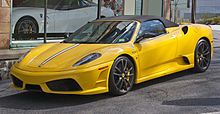
To commemorate Ferrari's 16th victory in the Formula 1 Constructor's World Championship in 2008, Ferrari unveiled the Scuderia Spider 16M at World Finals in Mugello. It is a convertible version of the 430 Scuderia.
The engine is rated at 510 PS (375 kW; 503 hp) at 8,500 rpm and 471 N⋅m (347 lb⋅ft) of torque at 5,250 rpm. The car has a dry weight of 1,340 kg (2,954 lb) (80 kg (176 lb) lighter than the F430 Spider) and a kerb weight of 1,440 kg (3,175 lb). The chassis was stiffened to cope with the extra performance available and the car featured many carbon fibre parts and weight saving measures as standard such as lightened front and rear bumpers. Unique 5-spoke forged wheels were specifically produced for the 16M and helped to considerably reduce unsprung weight with larger front brakes and calipers added for extra stopping power (also featured on 430 Scuderia). It accelerates from 0-100 km/h (62 mph) in 3.7 seconds, with a top speed of 315 km/h (196 mph).[19]
499 cars were produced beginning early 2009 and all were pre-sold to select clients.[20]
Special editions[edit]
F430 Spider Bio Fuel[edit]
A version of the F430 Spider that runs on ethanol, called the F430 Spider Bio Fuel, was on display at the 2008 Detroit Auto Show.[21] It had the same 4.3 litre V8 engine as the standard car, producing 500 hp (373 kW), with a 4% increase in torque and with 5% less carbon dioxide emissions than the standard F430 Spider.[21]
SP1[edit]

The F430-based Ferrari SP1 (Special Project Number 1), was the first one-off special produced by the Ferrari Portfolio Coachbuilding Programme, also known as the Special Projects Programme (SP). The body was designed by former Pininfarina designer Leonardo Fioravanti, at the behest of Junichiro Hiramatsu, a Japanese businessman who was the former president of the Ferrari Club of Japan and an avid collector; he had admired Fioravanti's 1998 F100 prototype.[22]
Racing[edit]
F430 Challenge[edit]

The F430 Challenge is the track version of the F430, designed for the Ferrari Challenge. The engine remained untouched but the vehicle's weight was reduced, resulting in a top speed of 325 km/h (202 mph). The production model was unveiled at the Los Angeles Auto Show in January 2005.
F430 GTC[edit]


Built since 2006 by Ferrari Corse Clienti department in collaboration with Michelotto, the F430 GTC is a racing car designed to compete in international GT2 class competition, such as in the American Le Mans Series, Le Mans Series, and FIA GT Championship. F430 GTCs also compete at the 24 Hours of Le Mans. The GTC was the fastest and most developed racing version of the F430.
In FIA GT2 championship, in order to render the car performances more uniform, the cars are forced to run with a specific minimum weight and with an engine restrictor that depends on the engine displacement.[23] Hence Ferrari destroked the 4.3 L V8 engine to 4.0 L in order to compete in the 3.8–4.0 L class in GT2 class racing, which is allowed to race with a minimum weight of 1,100 kg (2,425 lb).[23] In this race configuration, the engine produces somewhat less power (445 PS (327 kW; 439 hp)) and by using the 4.0 L engine, the minimum weight of the F430 would increase by 50 kg (110 lb).[23] but this is compensated by the reduced weight of the car, which yields a better power-to-weight ratio.
The F430 GTCs won their class championships in the ALMS and FIA GT, as well as scoring class wins at the 2007,[24] 2009 and 2010 12 Hours of Sebring, at the 2008 and 2009 24 Hours of Le Mans and at the 2008 and 2009 Petit Le Mans.
F430 GT3[edit]

Originally based on the F430 Challenge, the F430 GT3 is a specialised racing car developed in 2006 by JMB Racing for the FIA GT3 European Championship and other national GT championships such as British GT and FFSA GT. It is mechanically similar to the F430 Challenge but has better-developed aerodynamics and more power.
The car uses the same 4.3 L V8 engine, tuned to produce 550 hp (410 kW; 558 PS), making the GT3 more powerful than its GT2 counterpart. However, due to the GT3 regulations stating that the car must have a power-to-weight ratio of around 2.6 kg/hp, the car weighs 1,219 kg (2,687 lb) in race trim (driver and fuel excluded),[25] which is roughly 119 kg (262 lb) more than the GT2 spec car. Despite the higher power, it is significantly slower than the GT2 version; for example, in the 2007 Spa 24 Hours endurance race, in which both models were entered, the GT3 spec vehicles' best qualification time was around 8 seconds slower per lap than that set by the GT2 spec vehicle.
430 GT3 Scuderia[edit]
Developed by Kessel Racing for the 2009 season, the 430 GT3 Scuderia is the successor of the previous F430 GT3.[citation needed]
Recall[edit]
In February 2009, Ferrari recalled about 2,000 (2005–2007) F430 Spiders in the U.S., due to the risk that heat from the engine could cause the convertible top's hydraulic hoses to fracture and leak flammable fluid onto the engine, resulting in a fire.[26]
References[edit]
- ^ "Frank Stephenson: The Story". frankstephenson.com. Archived from the original on 17 June 2019. Retrieved 10 June 2019.
- ^ a b "Ferrari F430". ferrari.com. Retrieved 10 June 2019.
- ^ "2006 Chevrolet Corvette Z06 vs. 2006 Ferrari F430, 2007 Porsche 911 Turbo" (PDF).
- ^ "2006 Ferrari F430 Spider F1 vs. Lamborghini Gallardo Spyder" (PDF).
- ^ "2009 Ferrari 430 Scuderia Spider 16M Second Drive". 19 June 2009.
- ^ "2008 Ferrari 430 Scuderia First Drive Review". December 2007.
- ^ a b c "2005 Ferrari F430 Press Release Kit". Ferrari Press Release. Retrieved 2007-04-17.
- ^ "2010 Ferrari 458 Italia Press Release Kit". carsuk. 28 July 2009. Retrieved 2009-07-28.
-
Zelda
Zelda theme by Chalde
Download: zelda.p3t
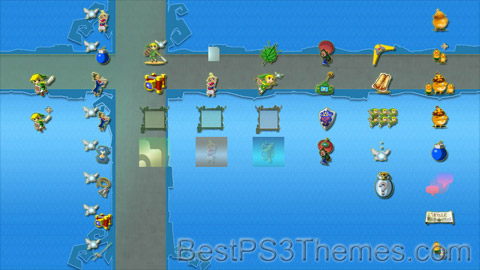
(1 background)
 Look up Zelda in Wiktionary, the free dictionary.
Look up Zelda in Wiktionary, the free dictionary.Zelda may refer to:
Places[edit]
- Zelda, Kentucky, unincorporated community, United States
People[edit]
- Zelda (given name), a female given name
Arts and entertainment[edit]
Media[edit]
- The Legend of Zelda, a video game franchise
- Zelda (Game & Watch), a 1989 Game & Watch system
- Zelda (band), a Japanese rock band in the 1980s and 1990s
- Zelda (film), a 1993 television movie
- Zelda, a 1970 book by Nancy Milford about Zelda Fitzgerald
Fictional characters[edit]
- Princess Zelda, the titular character in The Legend of Zelda video game series
- Zelda, in Stephen King's book Pet Sematary and the film adaptation
- Zelda, the main villainess in the British TV series Terrahawks
- Zelda, the main villainess in the 1998 direct-to-video film The Swan Princess: The Mystery of the Enchanted Kingdom
- Zelda, the dog mascot of Nickelodeon Magazine
- Zelda, the pet vulture in the 1964 TV series The Addams Family
- Zelda Cruz, a character in the American web series Zombie College
- Zelda Gilroy, in the 1959–1963 TV series The Many Loves of Dobie Gillis
- Zelda Kay, in the Island at War television mini-series
- Zelda Reginhard, in the anime and manga series Lotte no Omocha!
- Zelda Schiff, Head Librarian in the TV series The Magicians
- Zelda Spellman, Sabrina's aunt in Sabrina the Teenage Witch
- Zelda Spooner, in Billy Wilder's 1964 comedy film Kiss Me, Stupid
- "Zelda the Great", an episode and eponymous villain in the 1966 TV series Batman
Other uses[edit]
- Zelda (turkey), the wild turkey resident in Battery Park, Manhattan
- Zelda (זלדה), Israel Defense Forces soldiers' nickname for the M113 Armored Personnel Carrier
- Typhoon Zelda, two tropical cyclones
See also[edit]
Shadow of the Colossus
Shadow of the Colossus theme by Junkiexxl
Download: sotc.p3t
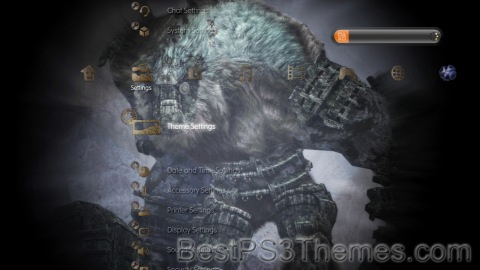
(3 backgrounds)
Shadow of the Colossus 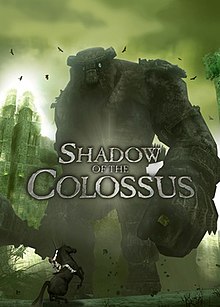 European cover art
European cover artDeveloper(s) Japan Studio (Team Ico) Publisher(s) Sony Computer Entertainment Director(s) Fumito Ueda Producer(s) Kenji Kaido Writer(s) - Junichi Hosono
- Masashi Kudo
- Takashi Izutani
Composer(s) Kow Otani Platform(s) PlayStation 2 PlayStation 3 PlayStation 4 Release Genre(s) Action-adventure, puzzle Mode(s) Single-player Shadow of the Colossus[a] is a 2005 action-adventure game developed by Japan Studio and Team Ico, and published by Sony Computer Entertainment for the PlayStation 2. It takes place in a fantasy setting and follows Wander, a young man who enters an isolated and abandoned region of the realm seeking the power to revive a girl named Mono. The player assumes the role of Wander as he embarks on a mission that might entail Mono's resurrection: to locate and destroy the colossi, sixteen massive beings spread across the forbidden land, which the protagonist traverses by horseback and on foot.
The game was directed by Fumito Ueda and developed at Sony Computer Entertainment's International Production Studio 1, also known as Team Ico, the same development team responsible for the acclaimed PlayStation 2 title Ico, to which the game is considered a spiritual successor. Сonceived as an online multiplayer game titled NICO directly after Ico's completion, Shadow of the Colossus underwent a lengthy production cycle during which it was redeveloped as a single-player title. The team sought to create an outstanding interactive experience by including a distinct visual design, an unorthodox gameplay template, and non-player characters with sophisticated artificial intelligence such as the colossi and Wander's horse, Agro.
Cited as an influential title in the video game industry and one of the best video games ever made, Shadow of the Colossus is often regarded as an important example of video games as art due to its minimalist landscape designs, immersive gameplay, and emotional weight of the player character's journey. It received wide critical acclaim by the media and was met with strong sales compared to Ico, due in part to a larger marketing campaign. The game won several awards for its audio, design, and overall quality. A remastered version for the PlayStation 3 was released alongside Ico as The Ico & Shadow of the Colossus Collection in September 2011, developed by Bluepoint Games, who later produced a high definition remake of the game for the PlayStation 4 in 2018.
Gameplay[edit]
Described by several commentators as an action-adventure game,[2][3] Shadow of the Colossus takes place from a third-person perspective in a three-dimensional (3D) graphic environment and involves combat-based gameplay sequences, as well as platforming and puzzle game elements.[4] The game's environment is largely presented as a seamless open world.[5] Progression through Shadow of the Colossus occurs in cycles. Beginning at a central point in an expansive landscape, the player seeks out and defeats a colossus, and is then returned to the central point to repeat the process.[2] To find each colossus, Wander may raise his sword while in a sunlit area to reflect beams of light, which will converge when the sword is pointed in the right direction of the next encounter.[6] The player's journey to a colossus seldom follows a direct route: stretches of varied terrain often require that a detour be taken along the way. Most colossi are situated in remote areas, such as atop cliffs or within ancient structures.[2][7]
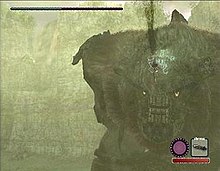
Wander climbs the first colossus to stab the sigil on its forehead. The heads-up display shows the character's health and stamina (lower right), as well as the colossus' health (upper left).[8] Once a colossus is found, the player must discover its weaknesses to defeat it. Each colossus dwells in a unique lair, and in most encounters the player must use some aspects of the current battlefield to advantage, a necessity that becomes more pronounced as the game progresses.[9] The first two battles take place on simple, vast, flat areas of land, wherein the player's only goal is to discover how to scale the colossi and attack their weak points.[6][9] However, the majority of the following fourteen battles require that the player make use of the surrounding environment.[10][11]
Every colossus has at least one weak point, symbolized by a glowing sigil[12] that can be illuminated and identified by the sword's reflected light.[6][13] Each colossus has areas covered with fur or protruding ledges, which Wander may use to grip and scale the colossus while it thrashes about in an attempt to dislodge him.[2] Wander has a limited stamina gauge that decreases as he hangs onto the colossus; the player thus must act quickly when they scale the creature.[4] Aside from the colossi, who are the only enemies of the game, the environment is inhabited by natural animals. Only one species, however, has an effect on gameplay: eating the tail of a certain kind of lizard increases Wander's stamina gauge. Likewise, the player may find fruit that increases Wander's maximum health.[14]
Wander's horse, Agro,[15] plays a large role in the game. Aside from her capacity as a means of transportation, Agro enables the player to fight from horseback, a critical avenue to defeating some of the colossi.[16] However, the game contains many environments that players cannot traverse by horse, and colossi are often found in areas within deep water or beyond large obstacles that must be scaled. Agro cannot travel beyond these, and when separated from Wander by such obstacles, cannot participate in the following battle.[6] While throughout the game, Wander's equipment consists of only a sword and a bow with arrows,[17] in subsequent playthroughs players may access bonus weapons and in-game features after finishing optional Time Attack trials, which allow the battles with the colossi to be replayed with a restricted time limit.[14]
Synopsis[edit]
Setting[edit]
Presented through a minimalistic narrative,[18] Shadow of the Colossus eschews disclosure of detailed information about the backstories and interrelationships of its characters to the player.[2] The game takes place in a fantasy world,[19][20] wherein a vast and unpopulated peninsula, known as the Forbidden Land, serves as the main setting for the game's events. Separated from the outside realm by a distant mountain range to its north and sea to the south and east, the area contains ruins and remnants of ancient structures, an indication that it had formerly been a settlement.[21][22][23]
The only point of entry to the region is a small cleft in the mountains to the north that leads to a massive stone bridge. This bridge spans half the distance of the landscape and terminates at a large temple called the "Shrine of Worship" located at its center. It is, however, forbidden to enter the land,[24] which includes diverse geographical features, such as lakes, plateaus, canyons, caves, and deserts in addition to human-made structures.[2][11]
Characters[edit]

Wander standing near Mono. Long hair served as a foundational aspect of both Wander and Mono's designs, and in the latter's case was meant to provide a visual contrast to Ico character Yorda.[25] The protagonist of the game is Wander (ワンダ, Wanda, voiced by Kenji Nojima), a young man whose goal is to resurrect a girl named Mono (モノ, voiced by Hitomi Nabatame). The only established fact regarding Mono is that she was a maiden who was sacrificed because she was believed to have a cursed destiny.[26] Assisting Wander in his quest to revive her is his loyal horse, Agro (アグロ, Aguro), who serves as his sole ally in defeating the colossi;[27] the English-language version of the game refers to Agro as a male steed,[28] although director Fumito Ueda said that he saw Wander's horse as female.[29] Wander also receives aid from an entity called Dormin (ドルミン, Dorumin, voiced by Kazuhiro Nakata and Kyōko Hikami). The story revolves around these characters but features a small supporting cast, represented by Lord Emon (エモン, voiced by Naoki Bandō) and his men.
Speaking with two voices at once (one male and one female), Dormin is a mysterious, disembodied entity. According to legends of the game's world, Dormin has the power to revive the dead;[24][27] this premise serves as the driving cause for Wander's entrance upon the forbidden land, as he seeks the being's assistance in reviving Mono. Dormin offers to revive her in exchange for Wander destroying the sixteen colossi.[26] One of the commentators of the game's plot speculated that the name "Dormin", which spells "Nimrod" backwards, serves as a reference to the body of the biblical King Nimrod which was cut up and scattered.[30]
Lord Emon is a shaman who narrates a vision in the game's introduction that vaguely explains the origin of the land to which Wander has come and establishes that entry to this place is forbidden.[24] As portrayed by the game, he possesses vast knowledge about the nature and containment of Dormin, and wields the ability to use powerful magic. He has a small group of warriors at his command, and is pursuing Wander to prevent the use of "the forbidden spell", the rite that involves the destruction of the sixteen colossi and the restoration of Dormin's power.[31]
The colossi are armored, most often enormous creatures with forms ranging from various humanoids to predatory animals, and live in all manner of surroundings and environments, including underwater and flying through the air.[18][32] Their bodies are a fusion of organic and inorganic parts such as rock, earth, and architectural elements,[4] some of which are weathered or fractured. Some colossi are peaceful and will only attack when provoked, whereas others are aggressive and will attack on sight.[2] Inhabiting specific locations in the forbidden land, they do not venture outside their own territory. Once slain they will remain where fallen, as a mound of earth and rock vaguely resembling the original colossus.[33][34] A pillar of light marks the location of each colossus after they are defeated.[35] The Latin names of the colossi, though spread throughout fan related media, are not official and are never referred to within the game.[36][37]
Plot[edit]
As the game begins, Wander enters the forbidden land and travels across a long bridge on his horse, Agro. After they reach the entrance to the Shrine of Worship, Wander, who has carried with him the body of Mono, brings her to an altar in the temple. A moment later, several humanoid shadow creatures appear and approach Wander before he easily dismisses them with a wave of the ancient sword in his possession.
After the shadow creatures are vanquished, the disembodied voice of Dormin manifests within the shrine and expresses surprise at the fact that Wander possesses the weapon. Wander explains the plight that led him to seek the forbidden land and asks that Dormin return Mono's soul to her body. Dormin offers to grant Wander's request under the condition that he completes a rite designed to destroy the sixteen idols lining the temple's hall. To that end, Wander must use his sword to slay each of the idol's physical incarnations–the colossi, whose presence ranges across the vast expanse outside the temple. Although warned by Dormin that he may have to pay a great price to revive Mono, Wander sets out to search the land for the colossi and destroy them.[38]
An aspect of Wander's mission that is unknown to him is that the colossi contain portions of Dormin's own essence, scattered long ago to render the entity powerless.[26][39] As Wander kills each colossus, a released fragment of Dormin enters his body. Over time, the signs of Wander's deterioration from the gathered essence start to appear: his skin becomes paler, his hair darker, and his face is increasingly covered by dark veins. The outcome of the battle with the twelfth colossus leads to a reveal of a group of warriors that has been pursuing Wander, led by Emon. Urged to hurry with his task by Dormin, Wander soon heads off to defeat the sixteenth and final colossus. On the way to this confrontation, he rides horseback across a long bridge which begins to collapse as he is halfway across, but Agro manages to throw Wander over to the other side before falling into the distant river below.
Soon after, Wander goes on to defeat the final colossus as Emon's company arrives in the Shrine of Worship to witness the last temple idol crumble. Wander appears back in the temple soon after, the signs of his corruption readily apparent: his skin is pallid, his eyes glow silver, and a pair of tiny horns have sprouted from his head. Emon recognizes him as a transgressor who, in an event that occurred before Wander's journey to the forbidden land, stole the ancient sword with which he killed the colossi.[31] Emon orders his warriors to kill the "possessed" man as he approaches Mono and finally falls once stabbed through the heart by one of Emon's men.[40] However, a newly whole Dormin takes control of Wander's body and transforms into a shadowy giant.[39][41] While his men flee, Lord Emon casts the ancient sword into a small pool at the back of the temple's hall to evoke a whirlwind of light. The supernatural vortex consumes Dormin and Wander, which seals Dormin within the temple once again. As Emon and his warriors escape, the bridge that leads to the temple collapses behind them, and its destruction forever isolates the forbidden land from the rest of the world. Although he has condemned Wander for his actions prior to their encounter, Emon expresses hope that Wander may be able to atone for his crimes one day should he have survived.[42]
Back in the temple, Mono awakens and finds Agro limping into the temple with an injured hind leg. Mono follows Agro to the pool into which Wander and Dormin were pulled by Emon's spell, where she finds a male infant with tiny horns on his head. Mono takes the child with her, following the horse to higher levels of the Shrine of Worship, and arrives at a secret garden within the shrine as the game ends.
Development[edit]
Origin[edit]

The monster movie genre, of which the original Godzilla film (1954 theatrical poster pictured above) is a famous example, served as a source of inspiration for the concept of Shadow of the Colossus. Shadow of the Colossus is the second project of Team Ico, a group of staff members within Sony Computer Entertainment's (SCEI) International Production Studio 1 that was led by director Fumito Ueda and producer Kenji Kaido.[32][43][44] The game originated from one of Ueda's concepts that he developed directly after the team submitted their debut title Ico, released in late 2001 for Sony's PlayStation 2 video game console, for publication.[45][46][47] As the basis of Team Ico's subsequent game had not been decided, Ueda examined "a number of old ideas kicking around in my head ... that couldn't be realized under previous circumstances".[48] After a brief review of those avenues, Ueda chose to explore one that aligned with his own preferences as a game player.[47][48] Ueda cited The Legend of Zelda series as an influence, as he grew up wanting to make a game like Zelda and designed the Colossi bosses like "inverted Zelda dungeons."[49][50]
Ueda envisioned a work with an underlying motif of "cruelty as a means of expression".[48] He felt that this theme was widely featured in contemporary titles such as Grand Theft Auto III and wanted to use it in a game that he designed.[48] In a discussion with Kaido, Ueda observed that he had played a variety of video games containing battles with large bosses that the player must shoot from a distance to defeat.[51] Ueda believed that the boss sequences of those games could be streamlined if the player character was able to approach and climb the oversized opponents to kill them with a close range weapon.[51] Accordingly, he chose to base the game around the player character's encounters with enormous fictional creatures,[16] a premise that stemmed from Ueda's childhood fascination with monster movies.[46] This led to an emphasis on the inclusion of a large-scale adventure in the title, an element which Ueda regarded as influential in the shaping of the game's stylistic identity.[48]
Originally, the team considered Ueda's idea alongside another concurrently-developed game.[45][46] According to Ueda, the game was unrelated to his former concept, and the team did not give it a working title or outline its design while it was in development.[45][46] Ueda recognized the finished iteration of Team Ico's second title as, "in many ways, a game for boys and men"; conversely, the separately produced game was fashioned to appeal more to a female audience.[46] Its contents, interface and thematic focus differed significantly from those that would ultimately manifest in the team's next game after Ico.[46] The untitled game did not employ 3D graphics, whereas Team Ico applied them to their published game.[46] The team eventually scrapped their plans for a counterpart title to Ueda's intended game,[46] which was advanced into further development.[45]
Prior to the start of the project, Team Ico assessed the opportunity to establish it as a sequel to their first game.[16] This suggestion was opposed by certain staff members who argued that the story and gameplay of their preceding title were largely self-contained, and that the existence of consumer demand for a new Ico game was questionable.[52] According to Ueda, Team Ico assumed that the creation of levels for a single-player game akin to Ico necessitated the construction of elaborate puzzles, a practice that the staff wanted to eschew.[51] Following lengthy deliberations, they decided not to pursue a sequel to Ico and to produce a standalone game provisionally dubbed NICO (a portmanteau of ni, 2 in Japanese, and "Ico").[16][32] The team initially agreed to develop NICO as an online multiplayer game that, unlike Ico, "wouldn't require complex level design".[51] Their foundational goal, according to Kaido, was to create a technology demo that represented a tentative rendition of the game's fictional world and features.[16] Development commenced immediately after the December 2001 release of Ico's Japanese version.[16][53]
Early prototypes[edit]

Team Ico produced the technology demo for NICO, the initial online multiplayer-focused incarnation of Shadow of the Colossus, using the native graphical capabilities of the PlayStation 2 (shown here with its Network Adaptor attached). To develop the concept video for NICO, Team Ico formed a small internal group, which was composed of Ueda, one of Ico's designers and a roughly 10-person animation team.[48] Their objective was to deliver "[a] movie with an extremely final form" that could serve as a visual template for the finalized game.[16] The first storyboard that outlined the video was drafted in January 2002, and the actual short film was completed that May.[54] It depicted a group of three masked, horned boys who rode horseback across a vast landscape and attacked a towering being reminiscent of the second boss in Shadow of the Colossus.[35][55][56] The video was visualized in the Ico game engine and was rendered in real-time on the PlayStation 2 hardware.[16] With those techniques, the team aimed to estimate the extent to which the platform's capabilities allowed the realization of their vision.[16]
According to Kaido, the team deemed the resulting video to have attained a very high level of completion, and thus was able to use it as a reference point throughout the game's production.[16] Although they subsequently modified the game's visuals from those of the demonstration reel, its themes of "fighting a giant enemy" and "[exploring] a giant field" carried over into the final game design.[16] The demo indicated elements that were excluded from the released game.[57] Among these was a showcased gameplay mechanism wherein one of the colossus' attackers who had scaled and killed it proceeded to mount his approaching horse by leaping onto its back from the entity's corpse.[57] The video was later exhibited at many trade shows,[43] such as the 2006 D.I.C.E. Summit in Las Vegas where Kaido and Ueda retrospectively discussed the game's development with Lorne Lanning.[55]
In June 2002, a small group of staff at Team Ico started to build a prototype of NICO for testing purposes.[54] In his role as producer, Kaido tasked the team with the inclusion of technological features that he recognized as important milestones of the development.[55] One of the challenges issued by Kaido involved the creation of "organic collision deformation", a term that alluded to his concept of realistic character physics in relation to the movement of the colossi.[55] For instance, if a colossus' limb was currently horizontal, Kaido expected the player to be able to run across the limb as though it were any other flat surface.[55] Ueda and Team Ico programmers spent over six months to produce a working version of this functionality.[54] They began by adding a character to a virtual environment where the figure was enabled to climb a pole-like object.[51] One of the team's priorities at the time was to code a physics-based simulation of scenarios where characters were "being shaken off or narrowly avoided being stomped on".[58]
In May 2003, Team Ico assembled a demonstrational build of NICO and presented it at a production meeting.[54] Full development of the game was sanctioned directly after it was pitched, and commenced in the same month.[54] That year, the NICO technology demo was shown across Sony's foreign offices among a lineup of prospective PlayStation 2 titles, and its exposure excited the spectators.[57] Although the team attempted to work on the game in secrecy, at a certain point images of NICO's horseriding characters were leaked onto the Internet.[32] Their circulation led enthusiasts to speculate about what they perceived as a sequel to Ico.[32] According to Ueda, the team reused elements of Ico's character designs for NICO to expedite the production of the concept video and minimize its costs.[58] He asserted that NICO was not related to Ico despite their stylistic similarities,[58] and that his colleagues did not identify the former game as a sequel.[4] However, contemporary and retrospective sources described Team Ico's second game as both a spiritual successor[32][47][59] and prequel to Ico.[60]
The staff used player feedback to advance the testing of the "organic collision deformation" system by inputting simple objects to experiment its capabilities.[58] Although Team Ico had conducted an elaborate research of the game's technological framework, they did not finish its validation when they entered the production phase.[51] After evaluating the limited number of personnel that was involved with NICO as well as their professional profiles, Team Ico concluded that they were not qualified to deliver an online-only game.[51] They then resolved to abandon that direction and to reformulate NICO into a single-player title.[51] The team discarded Ico's development tools that they had used at the outset of the project and moved to write new programming utilities.
Rainbow Glass
Rainbow Glass theme by KThing
Download: Rainbow_Glass.p3t

(1 background)
P3T Unpacker v0.12
Copyright (c) 2007. Anoop MenonThis program unpacks Playstation 3 Theme files (.p3t) so that you can touch-up an existing theme to your likings or use a certain wallpaper from it (as many themes have multiple). But remember, if you use content from another theme and release it, be sure to give credit!
Download for Windows: p3textractor.zip
Instructions:
Download p3textractor.zip from above. Extract the files to a folder with a program such as WinZip or WinRAR. Now there are multiple ways to extract the theme.
The first way is to simply open the p3t file with p3textractor.exe. If you don’t know how to do this, right click the p3t file and select Open With. Alternatively, open the p3t file and it will ask you to select a program to open with. Click Browse and find p3textractor.exe from where you previously extracted it to. It will open CMD and extract the theme to extracted.[filename]. After that, all you need to do for any future p3t files is open them and it will extract.
The second way is very simple. Just drag the p3t file to p3textractor.exe. It will open CMD and extract the theme to extracted.[filename].
For the third way, first put the p3t file you want to extract into the same folder as p3textractor.exe. Open CMD and browse to the folder with p3extractor.exe. Enter the following:
p3textractor filename.p3t [destination path]Replace filename with the name of the p3t file, and replace [destination path] with the name of the folder you want the files to be extracted to. A destination path is not required. By default it will extract to extracted.filename.bigcman321’s Theme
Custom PS3 theme by bigcman321
Download: Custom_PS3_Theme_by_bigcman321.p3t

(1 background)
P3T Unpacker v0.12
Copyright (c) 2007. Anoop MenonThis program unpacks Playstation 3 Theme files (.p3t) so that you can touch-up an existing theme to your likings or use a certain wallpaper from it (as many themes have multiple). But remember, if you use content from another theme and release it, be sure to give credit!
Download for Windows: p3textractor.zip
Instructions:
Download p3textractor.zip from above. Extract the files to a folder with a program such as WinZip or WinRAR. Now there are multiple ways to extract the theme.
The first way is to simply open the p3t file with p3textractor.exe. If you don’t know how to do this, right click the p3t file and select Open With. Alternatively, open the p3t file and it will ask you to select a program to open with. Click Browse and find p3textractor.exe from where you previously extracted it to. It will open CMD and extract the theme to extracted.[filename]. After that, all you need to do for any future p3t files is open them and it will extract.
The second way is very simple. Just drag the p3t file to p3textractor.exe. It will open CMD and extract the theme to extracted.[filename].
For the third way, first put the p3t file you want to extract into the same folder as p3textractor.exe. Open CMD and browse to the folder with p3extractor.exe. Enter the following:
p3textractor filename.p3t [destination path]Replace filename with the name of the p3t file, and replace [destination path] with the name of the folder you want the files to be extracted to. A destination path is not required. By default it will extract to extracted.filename.onyXMB
onyXMB theme by SectionZ
Download: onyXMB.p3t
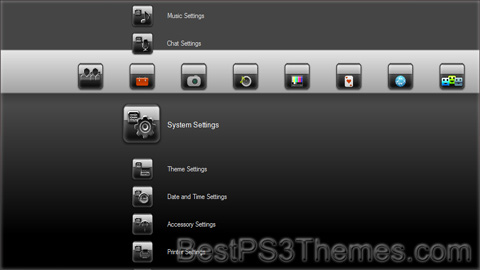
(1 background)
P3T Unpacker v0.12
Copyright (c) 2007. Anoop MenonThis program unpacks Playstation 3 Theme files (.p3t) so that you can touch-up an existing theme to your likings or use a certain wallpaper from it (as many themes have multiple). But remember, if you use content from another theme and release it, be sure to give credit!
Download for Windows: p3textractor.zip
Instructions:
Download p3textractor.zip from above. Extract the files to a folder with a program such as WinZip or WinRAR. Now there are multiple ways to extract the theme.
The first way is to simply open the p3t file with p3textractor.exe. If you don’t know how to do this, right click the p3t file and select Open With. Alternatively, open the p3t file and it will ask you to select a program to open with. Click Browse and find p3textractor.exe from where you previously extracted it to. It will open CMD and extract the theme to extracted.[filename]. After that, all you need to do for any future p3t files is open them and it will extract.
The second way is very simple. Just drag the p3t file to p3textractor.exe. It will open CMD and extract the theme to extracted.[filename].
For the third way, first put the p3t file you want to extract into the same folder as p3textractor.exe. Open CMD and browse to the folder with p3extractor.exe. Enter the following:
p3textractor filename.p3t [destination path]Replace filename with the name of the p3t file, and replace [destination path] with the name of the folder you want the files to be extracted to. A destination path is not required. By default it will extract to extracted.filename.Glass
Glass theme by KThing
Download: Glass.p3t

(1 background)

A glass building facade Glass is an amorphous (non-crystalline) solid. Because it is often transparent and chemically inert, glass has found widespread practical, technological, and decorative use in window panes, tableware, and optics. Some common objects made of glass like "a glass" of water, "glasses", and "magnifying glass", are named after the material.
Glass is most often formed by rapid cooling (quenching) of the molten form. Some glasses such as volcanic glass are naturally occurring, and Obsidian has been used to make arrowheads and knives since the Stone Age. Archaeological evidence suggests glassmaking dates back to at least 3600 BC in Mesopotamia, Egypt, or Syria. The earliest known glass objects were beads, perhaps created accidentally during metalworking or the production of faience, which is a form of pottery using lead glazes.
Due to its ease of formability into any shape, glass has been traditionally used for vessels, such as bowls, vases, bottles, jars and drinking glasses. Soda–lime glass, containing around 70% silica, accounts for around 90% of modern manufactured glass. Glass can be coloured by adding metal salts or painted and printed with vitreous enamels, leading to its use in stained glass windows and other glass art objects.
The refractive, reflective and transmission properties of glass make glass suitable for manufacturing optical lenses, prisms, and optoelectronics materials. Extruded glass fibres have applications as optical fibres in communications networks, thermal insulating material when matted as glass wool to trap air, or in glass-fibre reinforced plastic (fibreglass).
Microscopic structure[edit]

The amorphous structure of glassy silica (SiO2) in two dimensions. No long-range order is present, although there is local ordering to the tetrahedral arrangement of oxygen (O) atoms around the silicon (Si) atoms. 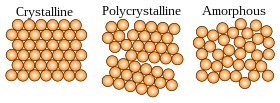
Microscopically, a single crystal has atoms in a near-perfect periodic arrangement; a polycrystal is composed of many microscopic crystals; and an amorphous solid such as glass has no periodic arrangement even microscopically. The standard definition of a glass (or vitreous solid) is a non-crystalline solid formed by rapid melt quenching.[1][2][3][4] However, the term "glass" is often defined in a broader sense, to describe any non-crystalline (amorphous) solid that exhibits a glass transition when heated towards the liquid state.[4][5]
Glass is an amorphous solid. Although the atomic-scale structure of glass shares characteristics of the structure of a supercooled liquid, glass exhibits all the mechanical properties of a solid.[6][7][8] As in other amorphous solids, the atomic structure of a glass lacks the long-range periodicity observed in crystalline solids. Due to chemical bonding constraints, glasses do possess a high degree of short-range order with respect to local atomic polyhedra.[9] The notion that glass flows to an appreciable extent over extended periods well below the glass transition temperature is not supported by empirical research or theoretical analysis (see viscosity in solids). Though atomic motion at glass surfaces can be observed,[10] and viscosity on the order of 1017–1018 Pa s can be measured in glass, such a high value reinforces the fact that glass would not change shape appreciably over even large periods of time.[5][11]
Formation from a supercooled liquid[edit]
Unsolved problem in physics :What is the nature of the transition between a fluid or regular solid and a glassy phase? "The deepest and most interesting unsolved problem in solid state theory is probably the theory of the nature of glass and the glass transition." —P.W. Anderson[12]
For melt quenching, if the cooling is sufficiently rapid (relative to the characteristic crystallization time) then crystallization is prevented and instead, the disordered atomic configuration of the supercooled liquid is frozen into the solid state at Tg. The tendency for a material to form a glass while quenched is called glass-forming ability. This ability can be predicted by the rigidity theory.[13] Generally, a glass exists in a structurally metastable state with respect to its crystalline form, although in certain circumstances, for example in atactic polymers, there is no crystalline analogue of the amorphous phase.[14]
Glass is sometimes considered to be a liquid due to its lack of a first-order phase transition[7][15] where certain thermodynamic variables such as volume, entropy and enthalpy are discontinuous through the glass transition range. The glass transition may be described as analogous to a second-order phase transition where the intensive thermodynamic variables such as the thermal expansivity and heat capacity are discontinuous.[2] However, the equilibrium theory of phase transformations does not hold for glass, and hence the glass transition cannot be classed as one of the classical equilibrium phase transformations in solids.[4][5]
Occurrence in nature[edit]
Glass can form naturally from volcanic magma. Obsidian is a common volcanic glass with high silica (SiO2) content formed when felsic lava extruded from a volcano cools rapidly.[16] Impactite is a form of glass formed by the impact of a meteorite, where Moldavite (found in central and eastern Europe), and Libyan desert glass (found in areas in the eastern Sahara, the deserts of eastern Libya and western Egypt) are notable examples.[17] Vitrification of quartz can also occur when lightning strikes sand, forming hollow, branching rootlike structures called fulgurites.[18] Trinitite is a glassy residue formed from the desert floor sand at the Trinity nuclear bomb test site.[19] Edeowie glass, found in South Australia, is proposed to originate from Pleistocene grassland fires, lightning strikes, or hypervelocity impact by one or several asteroids or comets.[20]
-
A piece of volcanic obsidian glass
-
Tube fulgurites
-
Trinitite, a glass made by the Trinity nuclear-weapon test
History[edit]
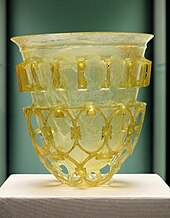
Roman cage cup from the 4th century BC Naturally occurring obsidian glass was used by Stone Age societies as it fractures along very sharp edges, making it ideal for cutting tools and weapons.[21][22]
Glassmaking dates back at least 6000 years, long before humans had discovered how to smelt iron.[21] Archaeological evidence suggests that the first true synthetic glass was made in Lebanon and the coastal north Syria, Mesopotamia or ancient Egypt.[23][24] The earliest known glass objects, of the mid-third millennium BC, were beads, perhaps initially created as accidental by-products of metalworking (slags) or during the production of faience, a pre-glass vitreous material made by a process similar to glazing.[25]
Early glass was rarely transparent and often contained impurities and imperfections,[21] and is technically faience rather than true glass, which did not appear until the 15th century BC.[26] However, red-orange glass beads excavated from the Indus Valley Civilization dated before 1700 BC (possibly as early as 1900 BC) predate sustained glass production, which appeared around 1600 BC in Mesopotamia and 1500 BC in Egypt.[27][28]
During the Late Bronze Age, there was a rapid growth in glassmaking technology in Egypt and Western Asia.[23] Archaeological finds from this period include coloured glass ingots, vessels, and beads.[23][29]
Much early glass production relied on grinding techniques borrowed from stoneworking, such as grinding and carving glass in a cold state.[30]
The term glass developed in the late Roman Empire. It was in the Roman glassmaking centre at Trier (located in current-day Germany) that the late-Latin term glesum originated, probably from a Germanic word for a transparent, lustrous substance.[31] Glass objects have been recovered across the Roman Empire[32] in domestic, funerary,[33] and industrial contexts,[34] as well as trade items in marketplaces in distant provinces.[35][36] Examples of Roman glass have been found outside of the former Roman Empire in China,[37] the Baltics, the Middle East, and India.[38] The Romans perfected cameo glass, produced by etching and carving through fused layers of different colours to produce a design in relief on the glass object.[39]
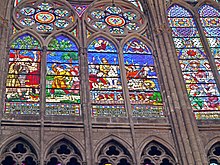
Windows in the choir of the Basilica of Saint-Denis, one of the earliest uses of extensive areas of glass (early 13th-century architecture with restored glass of the 19th century) In post-classical West Africa, Benin was a manufacturer of glass and glass beads.[40] Glass was used extensively in Europe during the Middle Ages. Anglo-Saxon glass has been found across England during archaeological excavations of both settlement and cemetery sites.[41] From the 10th century onwards, glass was employed in stained glass windows of churches and cathedrals, with famous examples at Chartres Cathedral and the Basilica of Saint-Denis. By the 14th century, architects were designing buildings with walls of stained glass such as Sainte-Chapelle, Paris, (1203–1248) and the East end of Gloucester Cathedral. With the change in architectural style during the Renaissance period in Europe, the use of large stained glass windows became much less prevalent,[42] although stained glass had a major revival with Gothic Revival architecture in the 19th century.[43]
During the 13th century, the island of Murano, Venice, became a centre for glass making, building on medieval techniques to produce colourful ornamental pieces in large quantities.[39] Murano glass makers developed the exceptionally clear colourless glass cristallo, so called for its resemblance to natural crystal, which was extensively used for windows, mirrors, ships' lanterns, and lenses.[21] In the 13th, 14th, and 15th centuries, enamelling and gilding on glass vessels were perfected in Egypt and Syria.[44] Towards the end of the 17th century, Bohemia became an important region for glass production, remaining so until the start of the 20th century. By the 17th century, glass in the Venetian tradition was also being produced in England. In about 1675, George Ravenscroft invented lead crystal glass, with cut glass becoming fashionable in the 18th century.[39] Ornamental glass objects became an important art medium during the Art Nouveau period in the late 19th century.[39]
Throughout the 20th century, new mass production techniques led to the widespread availability of glass in much larger amounts, making it practical as a building material and enabling new applications of glass.[45] In the 1920s a mould-etch process was developed, in which art was etched directly into the mould so that each cast piece emerged from the mould with the image already on the surface of the glass. This reduced manufacturing costs and, combined with a wider use of coloured glass, led to cheap glassware in the 1930s, which later became known as Depression glass.[46] In the 1950s, Pilkington Bros., England, developed the float glass process, producing high-quality distortion-free flat sheets of glass by floating on molten tin.[21] Modern multi-story buildings are frequently constructed with curtain walls made almost entirely of glass.[47] Laminated glass has been widely applied to vehicles for windscreens.[48] Optical glass for spectacles has been used since the Middle Ages.[49] The production of lenses has become increasingly proficient, aiding astronomers[50] as well as having other applications in medicine and science.[51] Glass is also employed as the aperture cover in many solar energy collectors.[52]
In the 21st century, glass manufacturers have developed different brands of chemically strengthened glass for widespread application in touchscreens for smartphones, tablet computers, and many other types of information appliances. These include Gorilla Glass, developed and manufactured by Corning, AGC Inc.'s Dragontrail and Schott AG's Xensation.[53][54][55]
Physical properties[edit]
Optical[edit]
Glass is in widespread use in optical systems due to its ability to refract, reflect, and transmit light following geometrical optics. The most common and oldest applications of glass in optics are as lenses, windows, mirrors, and prisms.[56] The key optical properties refractive index, dispersion, and transmission, of glass are strongly dependent on chemical composition and, to a lesser degree, its thermal history.[56] Optical glass typically has a refractive index of 1.4 to 2.4, and an Abbe number (which characterises dispersion) of 15 to 100.[56] The refractive index may be modified by high-density (refractive index increases) or low-density (refractive index decreases) additives.[57]
Glass transparency results from the absence of grain boundaries which diffusely scatter light in polycrystalline materials.[58] Semi-opacity due to crystallization may be induced in many glasses by maintaining them for a long period at a temperature just insufficient to cause fusion. In this way, the crystalline, devitrified material, known as Réaumur's glass porcelain is produced.[44][59] Although generally transparent to visible light, glasses may be opaque to other wavelengths of light. While silicate glasses are generally opaque to infrared wavelengths with a transmission cut-off at 4 μm, heavy-metal fluoride and chalcogenide glasses are transparent to infrared wavelengths of 7 to 18 μm.[60] The addition of metallic oxides results in different coloured glasses as the metallic ions will absorb wavelengths of light corresponding to specific colours.[60]
Other[edit]
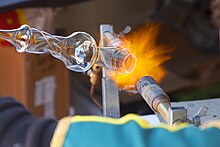
Glass can be fairly easily melted and manipulated with a heat source In the manufacturing process, glasses can be poured, formed, extruded and moulded into forms ranging from flat sheets to highly intricate shapes.[61] The finished product is brittle but can be laminated or tempered to enhance durability.[62][63] Glass is typically inert, resistant to chemical attack, and can mostly withstand the action of water, making it an ideal material for the manufacture of containers for foodstuffs and most chemicals.[21][64][65] Nevertheless, although usually highly resistant to chemical attack, glass will corrode or dissolve under some conditions.[64][66] The materials that make up a particular glass composition affect how quickly the glass corrodes. Glasses containing a high proportion of alkali or alkaline earth elements are more susceptible to corrosion than other glass compositions.[67][68]
The density of glass varies with chemical composition with values ranging from 2.2 grams per cubic centimetre (2,200 kg/m3) for fused silica to 7.2 grams per cubic centimetre (7,200 kg/m3) for dense flint glass.[69] Glass is stronger than most metals, with a theoretical tensile strength for pure, flawless glass estimated at 14 to 35 gigapascals (2,000,000 to 5,100,000 psi) due to its ability to undergo reversible compression without fracture. However, the presence of scratches, bubbles, and other microscopic flaws lead to a typical range of 14 to 175 megapascals (2,000 to 25,400 psi) in most commercial glasses.[60] Several processes such as toughening can increase the strength of glass.[70] Carefully drawn flawless glass fibres can be produced with a strength of up to 11.5 gigapascals (1,670,000 psi).[60]
Reputed flow[edit]
The observation that old windows are sometimes found to be thicker at the bottom than at the top is often offered as supporting evidence for the view that glass flows over a timescale of centuries, the assumption being that the glass has exhibited the liquid property of flowing from one shape to another.[71] This assumption is incorrect, as once solidified, glass stops flowing. The sags and ripples observed in old glass were already there the day it was made; manufacturing processes used in the past produced sheets with imperfect surfaces and non-uniform thickness (the near-perfect float glass used today only became widespread in the 1960s).[7]
A 2017 study computed the rate of flow of the medieval glass used in Westminster Abbey from the year 1268. The study found that the room temperature viscosity of this glass was roughly 1024 Pa·s which is about 1016 times less viscous than a previous estimate made in 1998, which focused on soda-lime silicate glass. Even with this lower viscosity, the study authors calculated that the maximum flow rate of medieval glass is 1 nm per billion years, making it impossible to observe in a human timescale.[72][73]
Types[edit]
Silicate glasses[edit]

Quartz sand (silica) is the main raw material in commercial glass production TripleTags
TripleTags theme by SectionZ
Download: TripleTags_XMB.p3t
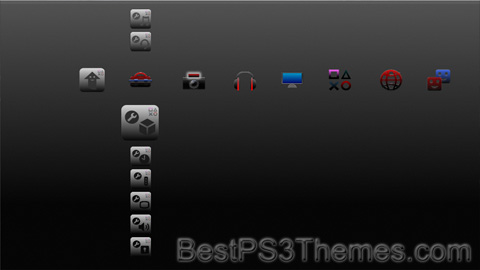
(3 backgrounds)
P3T Unpacker v0.12
Copyright (c) 2007. Anoop MenonThis program unpacks Playstation 3 Theme files (.p3t) so that you can touch-up an existing theme to your likings or use a certain wallpaper from it (as many themes have multiple). But remember, if you use content from another theme and release it, be sure to give credit!
Download for Windows: p3textractor.zip
Instructions:
Download p3textractor.zip from above. Extract the files to a folder with a program such as WinZip or WinRAR. Now there are multiple ways to extract the theme.
The first way is to simply open the p3t file with p3textractor.exe. If you don’t know how to do this, right click the p3t file and select Open With. Alternatively, open the p3t file and it will ask you to select a program to open with. Click Browse and find p3textractor.exe from where you previously extracted it to. It will open CMD and extract the theme to extracted.[filename]. After that, all you need to do for any future p3t files is open them and it will extract.
The second way is very simple. Just drag the p3t file to p3textractor.exe. It will open CMD and extract the theme to extracted.[filename].
For the third way, first put the p3t file you want to extract into the same folder as p3textractor.exe. Open CMD and browse to the folder with p3extractor.exe. Enter the following:
p3textractor filename.p3t [destination path]Replace filename with the name of the p3t file, and replace [destination path] with the name of the folder you want the files to be extracted to. A destination path is not required. By default it will extract to extracted.filename.XMBlu
XMBlu theme by SectionZ
Download: XMBlu.p3t
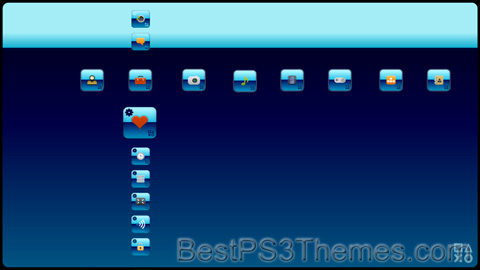
(1 background)
P3T Unpacker v0.12
Copyright (c) 2007. Anoop MenonThis program unpacks Playstation 3 Theme files (.p3t) so that you can touch-up an existing theme to your likings or use a certain wallpaper from it (as many themes have multiple). But remember, if you use content from another theme and release it, be sure to give credit!
Download for Windows: p3textractor.zip
Instructions:
Download p3textractor.zip from above. Extract the files to a folder with a program such as WinZip or WinRAR. Now there are multiple ways to extract the theme.
The first way is to simply open the p3t file with p3textractor.exe. If you don’t know how to do this, right click the p3t file and select Open With. Alternatively, open the p3t file and it will ask you to select a program to open with. Click Browse and find p3textractor.exe from where you previously extracted it to. It will open CMD and extract the theme to extracted.[filename]. After that, all you need to do for any future p3t files is open them and it will extract.
The second way is very simple. Just drag the p3t file to p3textractor.exe. It will open CMD and extract the theme to extracted.[filename].
For the third way, first put the p3t file you want to extract into the same folder as p3textractor.exe. Open CMD and browse to the folder with p3extractor.exe. Enter the following:
p3textractor filename.p3t [destination path]Replace filename with the name of the p3t file, and replace [destination path] with the name of the folder you want the files to be extracted to. A destination path is not required. By default it will extract to extracted.filename.















